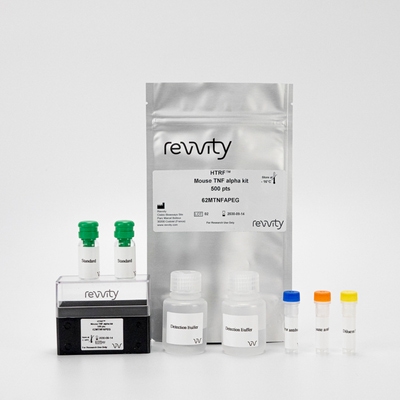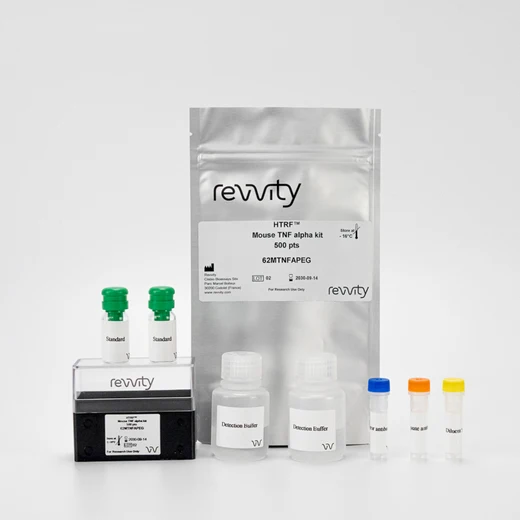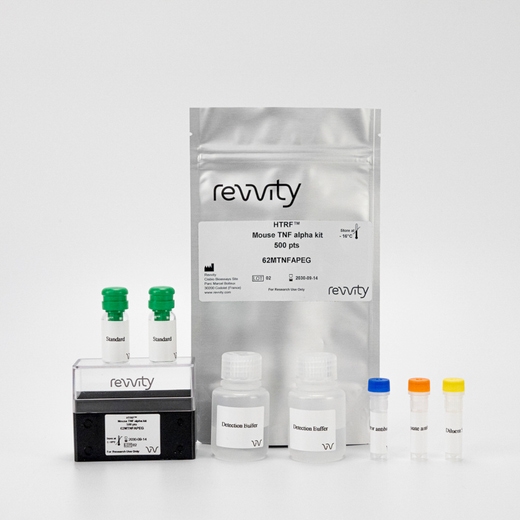

HTRF Mouse TNF-α Detection Kit, 10,000 Assay Points


HTRF Mouse TNF-α Detection Kit, 10,000 Assay Points






The HTRF mouse TNF alpha kit is designed for the quantification of mouse TNF alpha release in cell supernatant.
| Feature | Specification |
|---|---|
| Application | Protein Quantification |
| Sample Volume | 16 µL |
The HTRF mouse TNF alpha kit is designed for the quantification of mouse TNF alpha release in cell supernatant.



HTRF Mouse TNF-α Detection Kit, 10,000 Assay Points



HTRF Mouse TNF-α Detection Kit, 10,000 Assay Points



Product information
Overview
TNF alpha is a chemokine mainly produced by macrophages, T cells, and neutrophils. TNF alpha acts as a chemoattractant for neutrophils, and promotes infiltration and activation at inflammation sites. TNF alpha is involved in several cancer types for its ability to promote angiogenesis and cell proliferation, as well as to inhibit apoptosis.
Specifications
| Application |
Protein Quantification
|
|---|---|
| Brand |
HTRF
|
| Detection Modality |
HTRF
|
| Product Group |
Kit
|
| Sample Volume |
16 µL
|
| Shipping Conditions |
Shipped in Dry Ice
|
| Target Class |
Cytokines
|
| Target Species |
Mouse
|
| Technology |
TR-FRET
|
| Therapeutic Area |
Metabolism/Diabetes
NASH/Fibrosis
Oncology & Inflammation
|
| Unit Size |
10,000 Assay Points
|
Video gallery

HTRF Mouse TNF-α Detection Kit, 10,000 Assay Points

HTRF Mouse TNF-α Detection Kit, 10,000 Assay Points

How it works
Assay principle
Cell supernatant, sample, or standard is dispensed directly into the assay plate for the detection by HTRF® reagents (384-well low-volume white plate or Revvity low-volume 96-well plate in 20 µl). The antibodies labeled with the HTRF donor and acceptor are pre-mixed and added in a single dispensing step, to further streamline the assay procedure. The assay can be run up to a 1536-well format by simply resizing each addition volume proportionally.

Assay data analysis
The 4 Parameter Logistic (4PL) curve is commonly recommended for fitting an ELISA standard curve. This regression enables the accurate measurement of an unknown sample across a wider range of concentrations than linear analysis, making it ideally suited to the analysis of biological systems like cytokine releases.
To fully understand how to deal with HTRF data processing and also 4PL 1/y² fitting, please visit this page.
Revvity also worked with Myassays.com to help you in your data analysis.
Assay details
Technical specifications of mouse TNF alpha kit
| Sample size | 16 µL |
|---|---|
| Final assay volume | 20 µL |
| Kit components | Lyophilized standard, frozen detection antibodies, buffers &protocol. |
| LOD &LOQ (in Diluent) | 3 pg/mL &20 pg/mL |
| Range | 20 6,000 pg/mL |
| Time to result | 1h at RT |
| Species | Mouse only |
Analytical performance
Intra and inter assay
Intra-assay (n=24)
| Sample | Mean [TNFa] (pg/mL) | CV |
|---|---|---|
| 1 | 57 |
7% |
| 2 | 2570 | 2% |
| 3 | 5256 |
2% |
| Mean CV |
Each of the 3 samples was measured 24 times, and % CV was calculated for each sample.
Inter-assay (n=4)
| Sample | [TNFa] (pg/mL) | Mean (delta R) | CV |
|---|---|---|---|
| 1 | 93 | 457 | 2% |
| 2 | 493 | 2182 | 3% |
| 3 | 2609 | 8729 | 3% |
| Mean CV | 3% |
Each of the samples was measured in 4 different experiments, and % CV was calculated for each sample.
Resources
Are you looking for resources, click on the resource type to explore further.
The definitive guide to setting up a successful cytokine assay
Many therapeutic areas require an understanding of cytokine release...
This guide provides you an overview of HTRF applications in several therapeutic areas.
Loading...


How can we help you?
We are here to answer your questions.




































